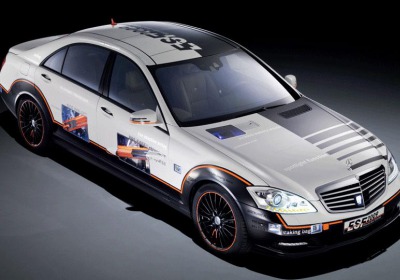Mercedes touts future safety with research vehicle
Tue, 07 Jul 2009In 1980, when several automakers began to use airbags, there were people who thought that cars couldn't possibly get any safer. Karl-Heinz Baumann, a safety researcher at Mercedes-Benz AG in Stuttgart, was not one of them.
"We said, 'No, it cannot be all,' and we kept doing more research."
The results of that research are presented on the company's most recent Experimental Safety Vehicle (ESV), on display now in the Mercedes Museum in Stuttgart. Baumann led a walkaround for us.
There are 27 innovations presented on the car, ranging from more clever use and placement of airbags to simple reflectors.
The ESV has bright orange reflector strips running down the sides, to show where greater use of that technology could be made. Production versions of the tape would be invisible except when headlights reflected on them.
Infrared cameras mounted within the ESV's headlight clusters scan for potential hazards such as pedestrians and animals. When one is detected, a bright LED light flashes onto the target.
Increased automatic car-to-car communications alert following drivers when another car's emergency flashers or electronic stability program are activated. The system also alerts the driver to approaching emergency vehicles. At a conference last month, the Mercedes ESV was able to communicate with a BMW and a Smart car.
The Braking Bag deploys 100 milliseconds before a frontal collision.
One of the more unusual functions on the ESV was the Braking Bag, an large, rubber-footed, airbag-deployed skid plate that lifts the front of the car off the ground 100 milliseconds before a frontal collision, slowing the car enough to lessen both damage and impact speed. Baumann said deploying the bag has the same effect as adding 7 inches of front structure.
To save weight, the metal side-impact beams in the doors inflate using the same propellant found in airbags, making the beams larger and stiffer. Imminent collisions would be recognized by side-mounted radars.
"It's like a Coke can," said Baumann. "You can crush it when it's empty but not when you fill it with 20 bar [290 psi] of pressure."
However, the system saves less than 5 pounds per car.
Inside the ESV are other protections.
Exactly 200 milliseconds before a side impact, the outboard side bolster of the front seat inflates to push the occupant 2 to 3 inches inward, away from the impact. To avoid front-seat passengers bonking heads in a side collision, another airbag inflates between them to absorb those potential blows. For rear-seaters in side-impact crashes, a central console deploys electrically. This console can also be deployed during normal driving to act as a headrest.
An airbag prevents front-seat occupants' heads from hitting together in a side crash.
In a frontal collision, tethers inside the front airbags unspool to adjust airbag size based on readings of occupant size, a solution more accurate than today's two-stage airbags.
At all seating positions, inflatable seat-belt airbags double the surface area across which the belt pulls, reducing potential injuries from the seatbelts. A new child seat shown in the ESV consists of side bolsters and a seat bottom but no seat back, increasing the amount of rear legroom for the kids.
Those are just the highlights. No decisions have been announced yet about which of these systems will make production.
You can see the car yourself, including all 27 innovations, at the enormous Mercedes Museum. The car will be on display there through Aug. 16. You also will be able to see a couple of ESVs from 40 years ago, back when we thought cars couldn't get any safer.
By Mark Vaughn

